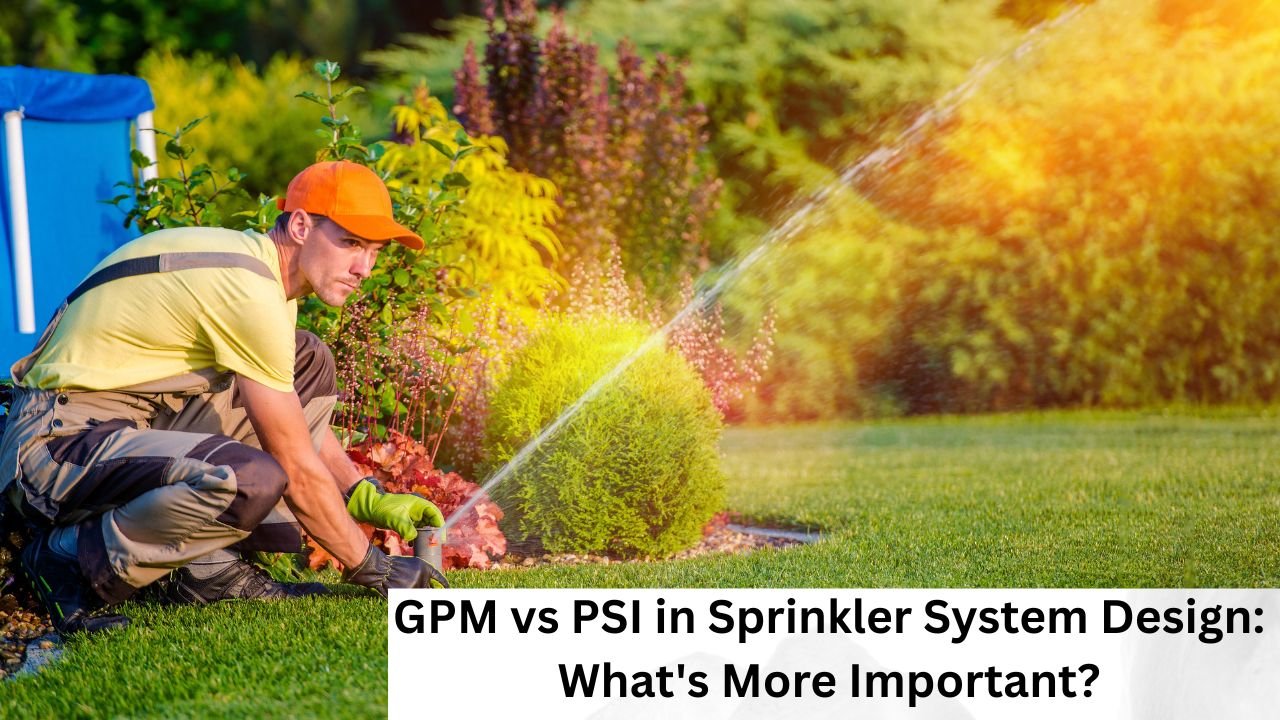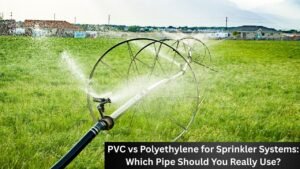GPM vs PSI in Sprinkler System Design: Which One Really Matters More?
I explain how water pressure and flow rate shape irrigation performance. The video below: Pressure (PSI) and Gallons Per Minute (GPM) by Oregon State University Turfgrass (YouTube, December 5, 2020) breaks the concepts down into easy, practical terms that anyone can apply to their system.
Think of PSI as the strength of a punch and GPM as the size of your fist. You need both to knock out dry patches. Too weak a punch, and even a big fist can’t help. Too small a fist, and a strong punch won’t land well. Same goes for sprinklers. PSI pushes the water. GPM is how much water is pushed. You need both working together.
But which is more important?
This GPM vs PSI sprinkler system guide will break it all down in plain English—no fluff, just facts that solve your sprinkler problems. And yes, this guide is designed for American homes, water systems, and lawns.
What Is PSI and Why It’s Critical
PSI (Pounds per Square Inch)
This tells you how hard the water is pushing through your pipes. It’s your system’s muscle.
- Static Pressure: Measured when nothing is running. Use a pressure gauge on an outdoor faucet.
- Dynamic Pressure: This is what really counts. It’s the pressure while water is actually flowing.
Want exact benchmarks? Check our Sprinkler Water Pressure Chart to match PSI with head types and system needs.
Ideal PSI Ranges
| Sprinkler Type | Ideal PSI Range | Why It Matters |
| Spray Heads | 25–35 PSI | Best for wide fan pattern with no misting |
| Rotors | 40–55 PSI | Ensures long throw and even rotation |
| Drip Emitters | 10–25 PSI | Prevents overwatering, perfect for roots |
Don’t guess your PSI—verify it before installation. Use both static and dynamic measurements. We explain that in more detail in our Sprinkler Installation Tips for Beginners.
What Is GPM and Why It Matters Too
GPM (Gallons Per Minute)
GPM tells you how much water flows per minute. It’s your system’s capacity.
How To Measure GPM (a.k.a. The Bucket Test)
- Grab a 5-gallon bucket.
- Use the spigot closest to your water meter.
- Turn water on full blast.
- Time how many seconds it takes to fill the bucket.
- Use this formula: (5 ÷ seconds) × 60 = GPM
Don’t design zones blindly. Calculate output per zone using our Sprinkler Zone Calculator.
The Dance Between PSI and GPM
You can’t choose one over the other. They’re teammates. Here’s how they play together:
Friction Loss
Water loses pressure the farther it travels and the more turns it makes. Narrow pipes, long runs, and too many fittings make it worse.
- Use bigger pipes if your flow is high.
- Keep runs straight if possible.
- Learn more about pipe sizing here
Elevation Changes
- Every foot you go uphill, you lose ~0.43 PSI.
- Every foot downhill, you gain ~0.43 PSI.
Design your zones with elevation in mind.
Source vs. System Pressure
Your house might have 70 PSI at the faucet. But your sprinkler head may only get 40 PSI once the water flows. That’s dynamic loss.
Zone vs. Supply GPM
If your system provides 15 GPM, don’t load a zone with heads that pull 18 GPM. Stay under the limit. Exceed it, and PSI crashes—your heads won’t perform.
Need help adjusting zones or fixing water starvation? Our Sprinkler System Repair Guide has common zone balancing fixes.
Sprinkler Head Specs
Every sprinkler head has charts that tell you:
- How far it sprays at each PSI
- How much water it uses (GPM)
Use these. Don’t guess. Manufacturers provide them for a reason. Or use our GPM Lookup Chart to make it easy.
How To Design A Balanced Sprinkler System
Measure Your Water Supply
- Use a pressure gauge for static PSI
- Do the bucket test for GPM
- To get dynamic PSI, run a zone and check pressure while sprinklers run
Map Your Lawn
Mark shaded areas, sunny spots, slopes. Each area may need different heads.
Create Zones
Each zone should:
- Match plant and sun needs
- Stay within your available GPM
- Use heads with the same precipitation rate
Choose The Right Heads
Match PSI and GPM to your water supply. Use nozzle charts. Make sure all heads in a zone are compatible. You can use the Sprinkler Zone Calculator to check and plan properly.
Pipe Sizing
Use hydraulic pipe sizing charts.
| Pipe Material | Best Use |
| PVC | Rigid, best for straight runs |
| Polyethylene | Flexible, great for curves and uneven terrain |
Too small a pipe = friction and pressure loss. Too large = wasted money.
Add Pressure Regulation
- Main Line Regulator: Protects the entire system
- Zone Regulator: For pressure-sensitive zones
- Pressure-Regulating Heads/Nozzles: Keep head-level pressure in check
Troubleshooting Guide: Real Problems, Real Fixes
Misting or Fogging?
Cause: Too much PSI
Fixes:
- Install a regulator
- Switch to pressure-regulated heads
Short Spray or Dead Zones?
Cause: Low GPM or PSI
Fixes:
- Check your GPM with the bucket test
- Reduce number of heads in a zone
- Re-size pipes if needed
- Add booster pump if supply is low
Runoff and Puddles?
Cause: Water comes out faster than soil can absorb
Fixes:
- Use cycle and soak
- Example: Water 10 minutes, wait 30, water again
For seasonal tune-ups, pressure testing, or valve failures, check our Sprinkler System Maintenance Guide before calling a tech.
Quick Takeaways
- GPM = How much water
- PSI = How hard water is pushed
- You need both to work in balance
- Always measure GPM and PSI before designing
- Never exceed your water source’s limits
- Use pressure regulators to control PSI
- Size pipes right to reduce friction loss
- Know your elevation changes
Final Thoughts:
When you understand how GPM and PSI work together, you stop guessing—and start engineering a lawn that thrives.
Know your numbers. Design smarter. Fix issues before they soak your wallet.
Check out our Sprinkler Head Spacing Guide next to make sure coverage hits every inch without waste.






